How I Sketch: Part One, Materials
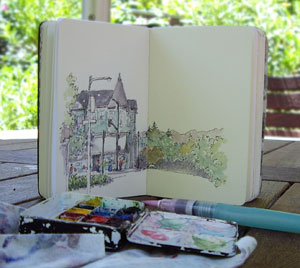 |
I am often asked for information on how to sketch, in particular how I do my sketching; the more detailed the better! After much trial I have developed a process that works for me, but I continue to learn and evolve as well. I thought I would describe what I’m currently doing, starting with my favorite materials.
The Kit
After trying virtually every art supply one can buy 🙂 , I finally settled on a stable set of tools. My kit goes everywhere with me so that I can always do a quick sketch when the opportunity arises. To realistically achieve this portability the components must be small. This requirement has largely dictated my choices:
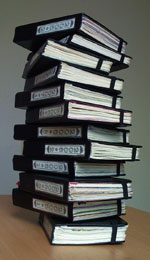
Sketchbooks
Sketchbook: I do all my sketching in small (“Pocket”, 3.5 x 5 inch) Moleskine notebooks that I rebind with 90lb hot press watercolor paper. I use the thicker (1 inch) “Planner” model because it holds more pages: 44 spreads to be exact. Occasionally a sketch fills only one side of a spread but usually I use the full (7 x 5 inch) page.
For the last few years I have filled at least three books a year. And, I am just finishing up Volume #4 for 2007 right now. Each year on January 1st I always start a new book: it can be a struggle to finish that last book by December 31st!
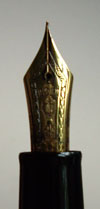
Sailor EF Nib
Pen: I use a Sailor fountain pen with an Extra Fine tip, which is made in Japan.
Quality fountain pens have two unique attributes that make them attractive for sketching. The first is the nib’s ball tip, which allows it to glide in all directions with ease. This can help keep the line work looser than that from a pen which favors one direction or needs to be pushed around.
The other important trait is nib flexibility, the extent of which varies in different types of pens. The stroke from a flexible pen changes width in response to the touch of the user creating a lively and personal line.
 Sailor Fountain Pen |
My pen is fairly flexible but what makes it ideal is it’s line weight. Because my sketchbook is small a fine line provides more versatility. Japanese pens run finer than do American or European, and this one draws the thinnest fountain pen line I’ve seen.
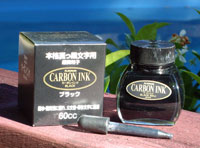
Carbon Ink
Ink: An ink converter allows the pen to utilize a bottled ink. I use Platinum Carbon Ink, which is a waterproof ink for fountain pens. Waterproof ink does not bleed or run when watercolor washes are laid on top of it. Although such ink is widely considered ruinous for fountain pens, mine have survived thus far. No guarantees though! It is important to use the pen daily to keep the ink flowing and flush it regularly with water to keep it from clogging up. I have found that modern pens stand up to the abuse of waterproof ink better than vintage pens.
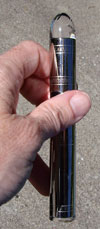
Traveling Ink Pot
Ink Pot: The Visconti Traveling Ink Pot is not cheap, but with it I can refill my fountain pen anywhere. I love it. The “pot” is sort of like a test tube that has a rubber neck at the top with a conical opening. One fits the pen snugly into the opening, turns the whole thing over so that the ink is above the pen, uses the pen’s filling mechanism to draw the ink down into it, and then flips everything back over to remove the pen. The outside stopper is very hard to get off (a good thing!) so I also carry a small piece of latex cut from a disposable glove which I can use to get a good grip on it. This ink pot works with many, but not all, fountain pens.
Paint Box: I carry a very small (2 X 3 inch) Winsor & Newton “Bijou” paint box. It has 18 mini pans (1/2 inch square) into which I squirt tube paint. The paint dries quickly (2-12 hours) so it doesn’t run, yet is easily reconstituted with water.
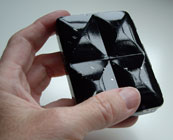
Paint Box Closed
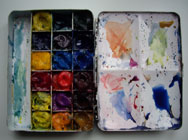
Paint Box Open
On the inside lid are four small mixing areas. The metal box is enameled white on the inside which provides a great mixing palette.
This particular box has not been made in some time (current boxes called “Bijou” are different: bigger overall with bigger “half pan” wells) and are hard to find. However, creative folks are hand making similar mini boxes with great success. I love my little box, although it’s taken quite a beating. When it finally gives out I am going to try crafting a replacement. If I change anything, it will be to use even less space for paints and a little more for mixing. I won’t make the box any bigger though!
Paint: I use Winsor & Newton “Artists Quality” watercolor paints in tubes.
| Colors I use most often: | ||||
| Raw Sienna Burnt Sienna French Ultramarine |
Cobalt Blue Permanent Alizarin Crimson Permanent Rose |
|||
| Other colors sometimes used: | ||||
| Lemon Yellow Aureolin Yellow Scarlet Red Cobalt Violet Indigo |
Sap Green Winsor Blue (Green Shade) Phthalo Green Manganese Blue |
|||
Waterbrush: The brush I use is the Niji waterbrush. It is especially convenient for sketching on the go.
 Waterbrush |
The soft plastic handle fills with water which is fed down into the brush head from inside as the handle is squeezed. With this brush you don’t need any open water container at all, which allows for painting in many more situations. The handle holds enough water for several sketches and is easily refilled by sink, glass, water bottle, creek, puddle, etc. These brushes come in a blue a clear plastic package and can be found in the US in larger art supply stores or online. Similar brushes are available in Europe and Asia as well.
Paper Towel: To change colors with the waterbrush you simply give it a little squeeze and soak up the water with a paper towel. I carry a piece of paper towel or sturdy napkin for this purpose.
Mechanical Pencil: Rarely used, but if needed I like a pencil that is always sharp.
Mini Eraser: When I do need to erase pencil lines, a soft white eraser is gentle on watercolor paper.
Pencil Bag: I have a typical student’s pencil bag (7 inches long, 3 inches high) that holds everything listed above except the sketchbook.
This little DIY sketching kit has served me well, on travels near and far. In fact, I do all of my sketching with these materials. The bag and sketchbook are very portable and I am able to keep them with me pretty much everywhere I go.
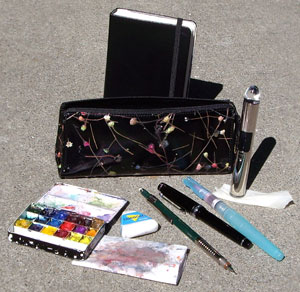 Portable Sketching Kit |
Continued In…
How I Sketch: Part Two, Demonstration
See Also
Moleskine Rebinding Project
Posts on Travel Sketching



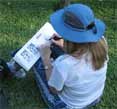

March 28th, 2017 at 10:12 am
Good morning,
Will you please help? I have several travel photos, and some watercolors inspired on them, but not able to start a travel book.How should it starts?
thanks.
Carolina
February 26th, 2016 at 7:42 am
It’s been 8 yrs since u put it post…still inspiring and motivational..thax mahn
September 30th, 2015 at 7:34 pm
What luck to have stumbled upon your post. I’ve read it twice and will read it many more times. Not because it is difficult to understand! Just the opposite! You have provided so much excellent formation and in a very professional, yet, reader friendly style. Thank you so much! I look forward to anything else you write!
April 20th, 2015 at 9:22 am
I love your website! You have inspired me to give this a try come this summer on my vacation to Playa del Carmen (Mexico)!
What are your thoughts about using the Prismacolor Premier Markers with the fine points, chisel point, and brush pen, instead of using a traditional pen/ink setup? I was thinking these markers would be easier to manage while traveling and since they are permanent after drying, they would work well with watercolors as well. Your thoughts? Do people use these as well as pen/ink?
August 27th, 2013 at 12:28 pm
Hi
Great little tutorial. Great sketches. Love your techniques. I wish I could “manage” the process as you have. I have difficult time knowing when to stop detailing but it’s coming along. Well, just wanted to say hello and admire your work.
Best,
Paul
October 9th, 2012 at 6:21 am
Five years later and your post continues to instruct and inspire. I found your website through a Pinterest pin. Thank you so much for sharing such great detail!
July 2nd, 2012 at 1:21 am
holy shit. this is amazing! :O i love your sketching kit!!!
June 10th, 2012 at 8:59 pm
what lovely precision to read about. Thank you for sharing your creative process and love of expression. You are a giver who is truly dedicated to art
April 23rd, 2012 at 5:23 pm
Hi: I love your revamped watercolor sketch books. I just wondered if you make them for sale? I would really like to have a few with Lanaquarelle hot press paper. Also do you have any recommendations for a good ink for the fountain pen that DOES make a wash? I really like the black washes in a drawing.
May 23rd, 2011 at 11:56 am
As a art lover I keep myself on a virtual journey for the art news.Today here I came as a passerby and returned with the link of your home page.Really a nice post!
May 15th, 2011 at 12:40 pm
Great sketch site – it IS fun to sketch and anyone can do it! Great way to really see a city, relax, and remember your journeys.
April 2nd, 2011 at 11:14 pm
I love your website and i absolutely love your sketches. I was once a boy who loved to draw but the art was lost in the world where jobs and schools and making a living are far more important. But I’m doing my backpacking trip throughout Europe in a week or so and i’m planning to sketch while i travel, i’m very excited. thanks for the info on the sketching kit, i’ll go get them tomorrow.
Keep up the passion and embrace your God’s gift.
simon
December 30th, 2010 at 7:41 am
I love your travel kit. Thanks for the great info!
Could you recommend a cheaper alternative to the Sailor FP that would also have a EF nib and be suitable for Carbon Black ink?
thanks,
Ed
December 18th, 2010 at 11:41 am
Wnderful inforaion for a beginner like myselft that wants to do my own book covers. Your methods are unique in my opinion and present a gentle personality in your work. I’ll be searching for more.
November 27th, 2010 at 4:17 pm
As an artist who has also tried every art supply until I was satisfied I took your thoughtful list seriously. I had tried Fountain Pens before, but decided to order the Sailor 1911 EF nib along with the Platinum Carbon Ink and Visconti Ink Pot. What a find!
I passed on Fountain pens before because I needed the waterproof element for washes and the dip pens were too messy with the shine from the Shellac of the India Ink always disappointing. I settled for Staedtler Pigment Liners and was quite happy until my ink started drying out. I started carrying a half a dozen ‘spares’ around until my portable pencil case was bulging! Your setup was completely satisfying to me. And the attractive Fountain Pen is an added bonus!
Your website is very thorough and refreshingly generous. Thank you and may your travels be plenty and inspiring!
June 15th, 2010 at 8:30 am
Your website is wonderful. I’m so glad to see people using the small sketchbooks. It seems that in art classes they are always trying to get us to use pads that are uncomfortably large for me (18×24 is WAY too big). My natural inclination is to work smaller, maybe not quite as small as you do but I haven’t really gotten started with outdoor sketching yet.
I’m a middle aged artist who got sidetracked by marraige, a software company job, and then widowhood. I did make a living selling my paintings of animals in San Francisco a long time ago, and illustrating software manuals later on.
Thank you once again for the wonderful help and examples.
June 4th, 2010 at 10:10 am
Wonderful advice, thank you very much 🙂
May 25th, 2010 at 3:56 pm
Really great to read this! I enjoyed the post tremendously but more for me is that people still take sketching while travelling seriously – you know like a part of a life style – I love it! It insipes me to pull out my still unfinished sketch books that I used to carry about with me. Thanks
March 15th, 2010 at 1:54 am
[…] There is of course a ton of useful info on-line about how to start doing all this, but I particularly liked this post, How I Sketch: Part Two, Demonstration, despite being obsessed, as a typical beginner, with all the nice things I can buy in her previous post, How I Sketch: Part One, Materials. […]
March 9th, 2010 at 6:17 am
i am 8 an i have been drawing since i was 2 and i want to learn more about sketching and is fun when ur bored
February 27th, 2010 at 4:56 am
Haven’t visited your site in a while – but it always inspires me! Thanks for all your beautiful posts.
February 12th, 2010 at 9:34 pm
“Reloaded moleskines”, “latex end-cap grippers”, “ink-converters.”
You are the freakin’ “MacGyver” of the sketchbook world!
I have been on a pilgrimage to find my perfect on-the-go sketch kit, and managed to find my way to a moleskine watercolor book and Niji waterbrushes, and now end up at your great website.
Thanks for sharing your knowledge and experience with everyone.
January 21st, 2010 at 2:18 am
ive been drawing since i was 3 y/o..it was only cartoons way back then..you know, x-men stuffs, anime’s etc.. actually ive filled a couple of sterling drawing pads with sketches and watercolor pictures. then i went to a blank or let’s just say ive been lazy to draw seriously again..until i saw this site.. now, im starting to draw/sketch outdoors to hone and improve my skills..thanks for the motivation!!..hehe..
ps.
i bought the same stuffs that you featured here on your site.or if not the exact stuff, something common. you know, i dont have any sponsors or sources..hahaha.. i love your masterpieces..it has that unlikely appeal on me..take care..!!
January 20th, 2010 at 10:11 pm
nice
.., that was gnarly
December 30th, 2009 at 10:48 am
Thank you for sharing this. I now have a kit like this and I have no problems with it at all. Thank you for sharing. I love your sketches. 🙂
December 12th, 2009 at 12:30 pm
Congratulations, Martha, your blog site on materials is fantastic! TEACHER LEARNS FROM STUDENT! So sorry I didn’t connect to your site sooner; just starting to use a computer. Thanks loads.
September 6th, 2009 at 2:19 pm
[…] noticed that Martha recently wrote a post showing her entire sketching kit. If you’re interested in sketching make sure to check out Martha’s beautiful and […]
April 4th, 2009 at 7:51 am
It’s really fun to see how another artist solves these travel problems. Half the creative joy of it seems to be finding a clever solution. I appreciate so much your willingness to break it down – I think I’ll try the book-binding. I’ve been carrying 20-sheet 6×6″ blocks of Portofino acquerello, hot-pressed, 140 lb. In addition to a paint kit, I carry a small travel-collage kit with scissors, pens, gluestick, and notebook. It’s great for trains and now, planes. I used to carry a small brush and a tiny jar of Golden medium, but gluesticks seem to be working as well for out-of-the-studio work.
Happy travels!!
January 16th, 2009 at 6:55 am
Great post! I love making up new ways to carry my art supplies around, and love making my kit smaller and smaller. I did a similar post on my blog awhile ago. I used the tiny painting kit you referred to…in an Altoids tin, is that what you meant? I end up taking my field box from Windsor Newton many times, I switch back and forth.
I like your blog! I hope you’ll visit mine and drop me a line,
keep sketching!